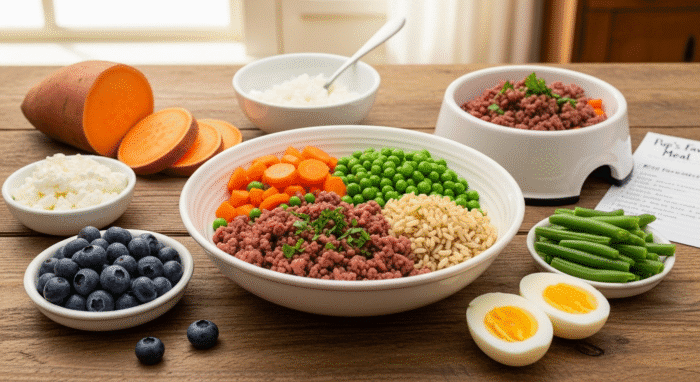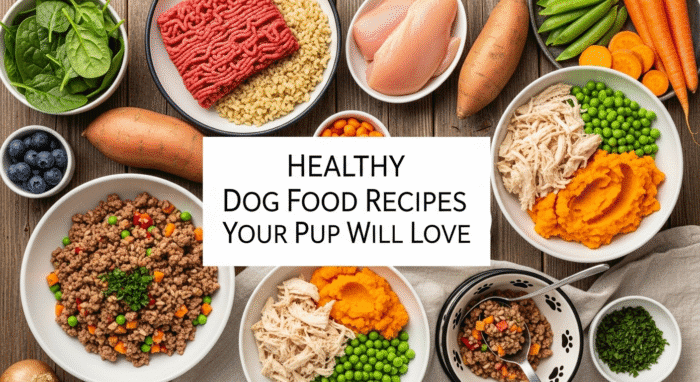Okay, let’s talk dog food. But not the dry, kibble-flying-everywhere kind of talk. I’m talking about real food. Food that makes your dog’s tail wag a little harder, food that might even make them do that happy little dance they do when they know something amazing is about to happen. You know the one. I’ve got to admit, seeing my own goofy Lab, Gus, lose his mind over a bowl of homemade goodness? That’s a feeling that never gets old.
We’ve all been there. Staring at the endless shelves of dog food, wondering what’s actually good for our furry best friends. Marketing claims, fancy packaging… it’s overwhelming! And honestly, a little unsettling. What is actually in that stuff anyway? Maybe you are wondering how to make sure your canine companion is thriving?
But here’s the thing: you CAN take control. You can make healthy, delicious meals for your dog right in your own kitchen. And it doesn’t have to be some crazy, complicated process. Trust me, if I can do it (and I am, shall we say, not a gourmet chef), you can too.
Table of Contents
Why Bother Making Your Own Dog Food?

Alright, fair question. Time is precious, after all. So why spend it chopping veggies and simmering meat for Fido? Well, for starters, you know exactly what’s going into their bowl. No mystery ingredients, no weird fillers, just whole, nutritious foods. And that, my friends, can make a world of difference in your dog’s health. Think shinier coat, better digestion (less, ahem, backyard surprises!), and maybe even a little extra pep in their step. Plus, it can be a surprisingly bonding experience. Gus definitely hangs around the kitchen a lot more when he knows I’m cooking for him.
And about those mysterious ingredients. Some commercial dog foods can contain questionable additives and preservatives. When you make your own, you’re in charge. The frustrating thing about this topic is the lack of transparency in some commercial pet food manufacturing, so its very difficult to fully trust labels and claims.
The Building Blocks of a Healthy Homemade Dog Food Recipe
Okay, let’s get down to brass tacks. What should you actually put in these recipes? The general rule of thumb is a balance of protein, carbohydrates, and healthy fats. Think of it like this: meat (or sometimes fish!), veggies, and maybe a little grain or starch to round it out. Sounds simple enough, right? But wait, there’s something even more interesting here. And it has to do with the types of each ingredient.
For protein, lean meats like chicken, turkey, or beef are great choices. Fish, especially salmon, is packed with omega-3 fatty acids, which are fantastic for skin and coat health. Avoid cooked bones! For veggies, think colorful. Carrots, sweet potatoes, broccoli, and green beans are all excellent options. Just be sure to avoid grapes, raisins, onions, and garlic, as they are toxic to dogs. And for carbs? Brown rice, quinoa, or even oats can work well. I initially thought only rice was a good option but quinoa and oats are surprisingly great for dogs.
Don’t forget healthy fats! A little olive oil or flaxseed oil can add extra benefits.
But here’s a little secret: Variety is key! Don’t just feed your dog the same thing every single day. Mix it up, experiment with different ingredients, and keep things interesting for their taste buds (and their overall health!). I keep coming back to this point because it’s crucial. Dogs, just like us, thrive on a diverse diet.
Simple, Delicious Recipes to Get You Started
Alright, enough theory! Let’s get cooking! Here are a couple of my go-to recipes that Gus absolutely loves. Feel free to adapt them based on what you have on hand and what your dog enjoys. And remember, portion sizes will vary depending on your dog’s size, age, and activity level. Talk to your vet if you’re unsure.
Recipe 1: Chicken and Veggie Delight
Ingredients:
- 1 lb ground chicken
- 1 cup chopped sweet potato
- 1 cup chopped carrots
- 1/2 cup chopped broccoli
- 1/2 cup brown rice (cooked)
- 1 tbsp olive oil
Instructions:
- Cook the ground chicken in a large skillet over medium heat until cooked through. Drain off any excess fat.
- Add the sweet potato, carrots, and broccoli to the skillet. Cook until the vegetables are tender, about 10-15 minutes.
- Stir in the cooked brown rice and olive oil. Mix well.
- Let cool completely before serving.
Recipe 2: Salmon and Quinoa Power Bowl
Ingredients:
- 1 lb salmon fillet (skin removed)
- 1 cup cooked quinoa
- 1 cup chopped green beans
- 1/2 cup chopped zucchini
- 1 tbsp flaxseed oil
Instructions:
- Bake the salmon fillet in a preheated oven at 375°F (190°C) until cooked through, about 12-15 minutes. Flake the salmon with a fork.
- Combine the flaked salmon, cooked quinoa, green beans, and zucchini in a large bowl.
- Stir in the flaxseed oil. Mix well.
- Let cool completely before serving.
And for a good measure, you might also want to check out this cool game Dog Simulator. It’s fun and interesting.
Important Considerations for Homemade Dog Food
Okay, here are a few things I’ve learned over time to keep in mind when switching to homemade dog food. Consulting with your veterinarian is absolutely crucial. They can help you create a balanced diet that meets your dog’s specific needs. And that’s super important. A balanced diet is what you want.
Also, start slowly! Don’t just switch your dog over to homemade food overnight. Gradually introduce it into their diet, mixing it with their old food until they’re fully transitioned. This will help prevent any tummy troubles.
FAQ: Homemade Dog Food Deep Dive
How do I know if my dog is getting the right nutrients?
This is a big one! Look for signs of a healthy dog: shiny coat, good energy levels, healthy weight, and normal bowel movements. If you notice any changes or concerns, talk to your vet. They can perform blood tests and other diagnostics to ensure your dog is getting everything they need. There are numerous sites that offer additional infomation regarding food preparations American Kennel Club website.
What if my dog is a picky eater?
Ah, the picky eater challenge! We’ve all been there. The trick is to experiment with different flavors and textures. Try adding a little low-sodium chicken broth or a sprinkle of parmesan cheese to make the food more appealing. You can also try warming the food slightly to enhance the aroma. If all else fails, try hand-feeding them a few bites to get them interested. Gus can be picky at times, believe it or not.
Can I freeze homemade dog food?
Absolutely! Freezing is a great way to meal prep and save time. Just portion the food into freezer-safe containers or bags and freeze for up to 2-3 months. Thaw in the refrigerator overnight before serving. I usually make a big batch on the weekend and freeze individual portions for the week.
Is making healthy dog food recipes really cheaper than buying commercial food?
It can be, depending on the ingredients you use and where you shop. Buying in bulk and using seasonal produce can help keep costs down. But honestly, for me, the peace of mind knowing exactly what my dog is eating is worth the extra effort, even if it’s not always cheaper. Think about it this way: you’re investing in their long-term health and well-being.
So there you have it. A little glimpse into the world of homemade dog food. It’s not rocket science, and it can be incredibly rewarding. Give it a try, experiment with different recipes, and see what your dog loves. You might just be surprised at the difference it makes. Happy cooking!

